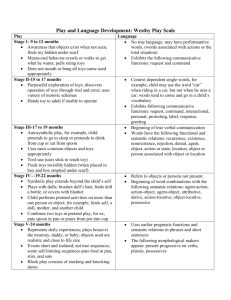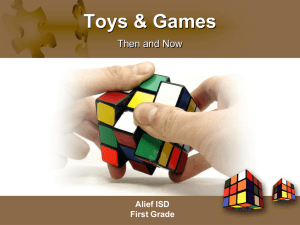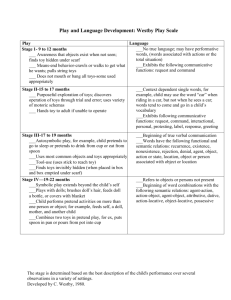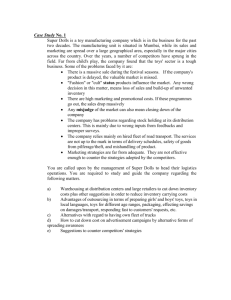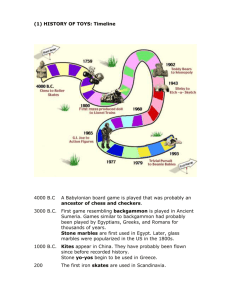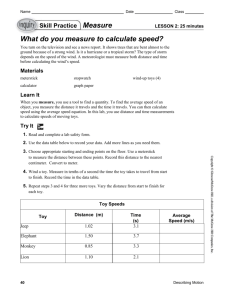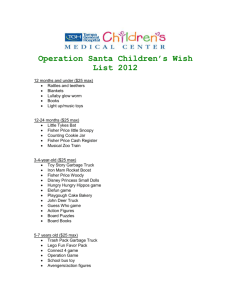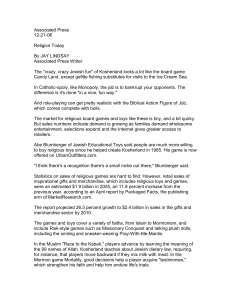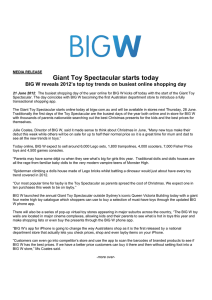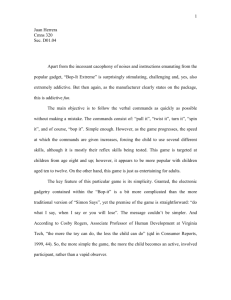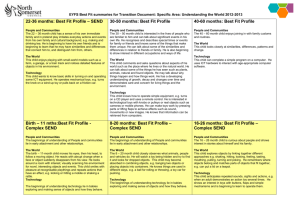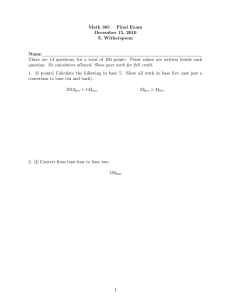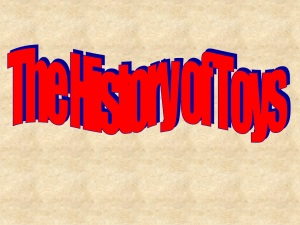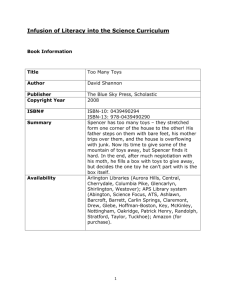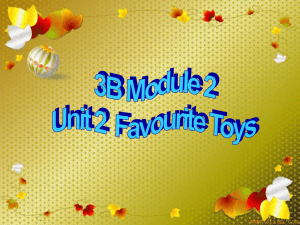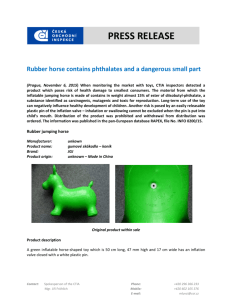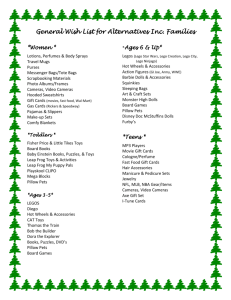Growing Up: A Developmental Curriculum by Noel B Croft Ed D. and
advertisement
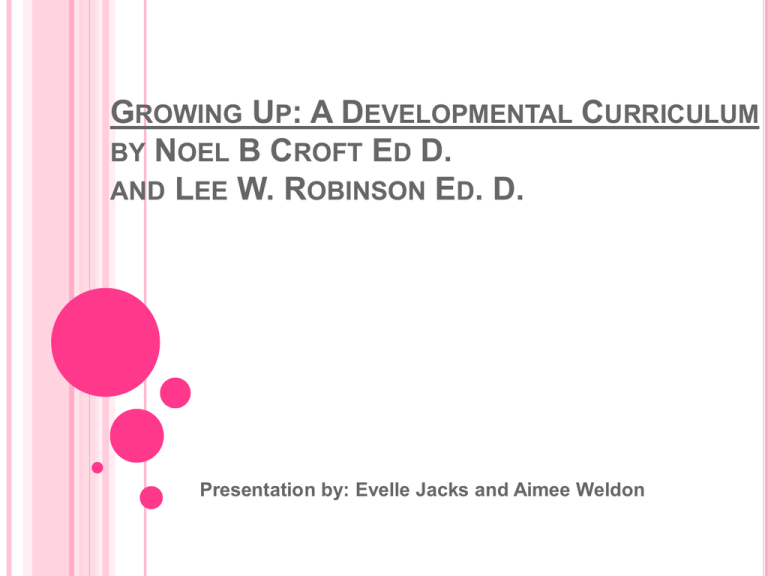
GROWING UP: A DEVELOPMENTAL CURRICULUM BY NOEL B CROFT ED D. AND LEE W. ROBINSON ED. D. Presentation by: Evelle Jacks and Aimee Weldon OVERVIEW: Assessment tool for individuals functioning in the birth to six year old range that links assessment directly to instruction and evaluation. Reminds teachers to consider what is important to the parents. Provides a structured program that links assessment directly to instruction and evaluation. The assessment is the foundation for building the curriculum. The Profile Chart makes small steps in learning apparent and easy to visualize for parents and teachers. GROWING UP COVERS SIX MAJOR AREAS: 1. Physical Development 2. Fine Motor 3. Self Help Skills 4. Social – Personal Development 5. Language Development 6. Intellectual Development Each major area is further divided into subdivisions to allow grouping of major skill areas. INITIAL ASSESSMENT QUESTIONNAIRE: is completed by the teacher to determine an appropriate place to begin instruction. The teacher will ask the parent to sort cards describing a representative sampling of behaviors in all six areas into three stacks: o Yes. The child can do the task or has done the task in the past. o No. The child does not do the task. o Don’t know. The child may occasionally perform the task. The teacher will then use the cards to fill in the questionnaire based on the parent’s responses. This will allow the teacher to be able to focus in on the appropriate area to begin instruction. PROFILE CHART: is a way to record the child’s abilities or strengths and provide a record of the child’s developmental progress. It also provides the child’s present level of functioning. The teacher will color in the boxes on the Profile Chart that represent the yes responses given by the parent. The teacher will then check the highest level of functioning in each of the areas on the profile chart by using the indexes in the curriculum handbook and ask the parent if the child can do the next highest items or by working with the child as described in the program cards. These items are then filled in on the profile chart. The Profile chart is then completed by coloring the boxes representing items that are below the colored item with the highest number in each sequence. If an item is far above the general performance level and has no supporting skills at previous levels, do not fill in the sequence because this is most likely a splinter skill or an inaccurate assessment. ACTIVITY RECORD: The teacher will then select the program cards to be used. The parent’s interest should be considered when selecting programming. The Activity Record Sheet is used to record the child’s responses. In general, the minimum standard for the completion of the task has been four out of five trials are successful. When the program has been completed and evaluated, the teacher is ready to move to the next task in the sequence. If the child was unable to perform the task move back to the preceding card in the sequence. TIPS FOR PARENTS AND TEACHERS: Once the programming cards are selected the program can be carried out by the parent or aide with the teacher conducting an evaluation at the end. The Curriculum guides provide easy to understand instructions for what the skill should look like. The materials and strategies suggested for use with this program are not exhaustive. They are suggestions and teachers should use what works for their student. Throughout the curriculum attempts are made to use multi sensory learning styles. Reverse Chaining has been used in the suggested approaches. In this method a task is divided into small steps. The child learns to complete the task by learning the last step first then the next to the last and so on until the whole task can be preformed. GROWING UP: A DEVELOPMENTAL CURRICULUM IS AVAILABLE FROM: Parent Consultants 570 E. North 3000 Ogden, UT EXAMPLE: 23PD3 AREA: Walking - 2 PRECEDING CARD: 7PD1 FOLLOWING CARD: 62PD9 TITLE: Lying - Soles of Feet Opposed BEEHAVIORAL DESCRIPTION: The child, when lying on his back, exerts pressure on the soles of his feet when he feels pressure on them. PROGRAMMING: Push the child's legs back and forth, and oppose the soles of his feet until he exerts pressure. Place in the child's hands objects which are bright colored and have definite tactual feel, such as a piece of upholstery velvet. Encourage the child to shake his hand or arm. Give him a slight tactual cue if needed. INDICATIONS Of DISABILITY: Lack of response to stimulation of either hands or feet may indicate disorder; further evaluation is advisable. MATERIALS: Bells, ribbons, upholstery fabric EXAMPLE: 50SP36 AREA: Play - 19 PRECEDING CARD: 43SP24 FOLLOWING CARD: 54SP36 TITLE: Combines Playthings BEHAVIORAL DESCRIPTION: The child develops and interest in combining his playthings, such as blocks and cars and makes such things as roads, garages, and bridges. PROGRAMMING Provide the child with toy cars, blocks, dolls, dollhouses, and similar types of toys. Encourage him to play with the toys. As he plays with the toys, the child will begin to use the toys in a situation which will require the use of two or more objects. When this occurs, give him some praise and ask him what he is doing or ask other questions about his activities. If the child has difficulty arriving at the level described in Item 2 above, play with him and encourage him to begin playing with more than one object at a time. Let him imitate your play. The child can increase his ability to do this type of activity if he is exposed to the actual situation before he begins to play with the model of the situation in the form of a toy car and garage, a doll and dollhouse, or a toy farm. The barnyard sets, small dollhouses with furniture, garage sets, model airports and schoolhouse, etc., with the family of dolls which fit the size of the child's small hand are particularly good for this age level of the child. MATERIALS: Toy cars, blocks, dolls, and hand-sized dolls dollhouses, model barnyards, garages, etc

